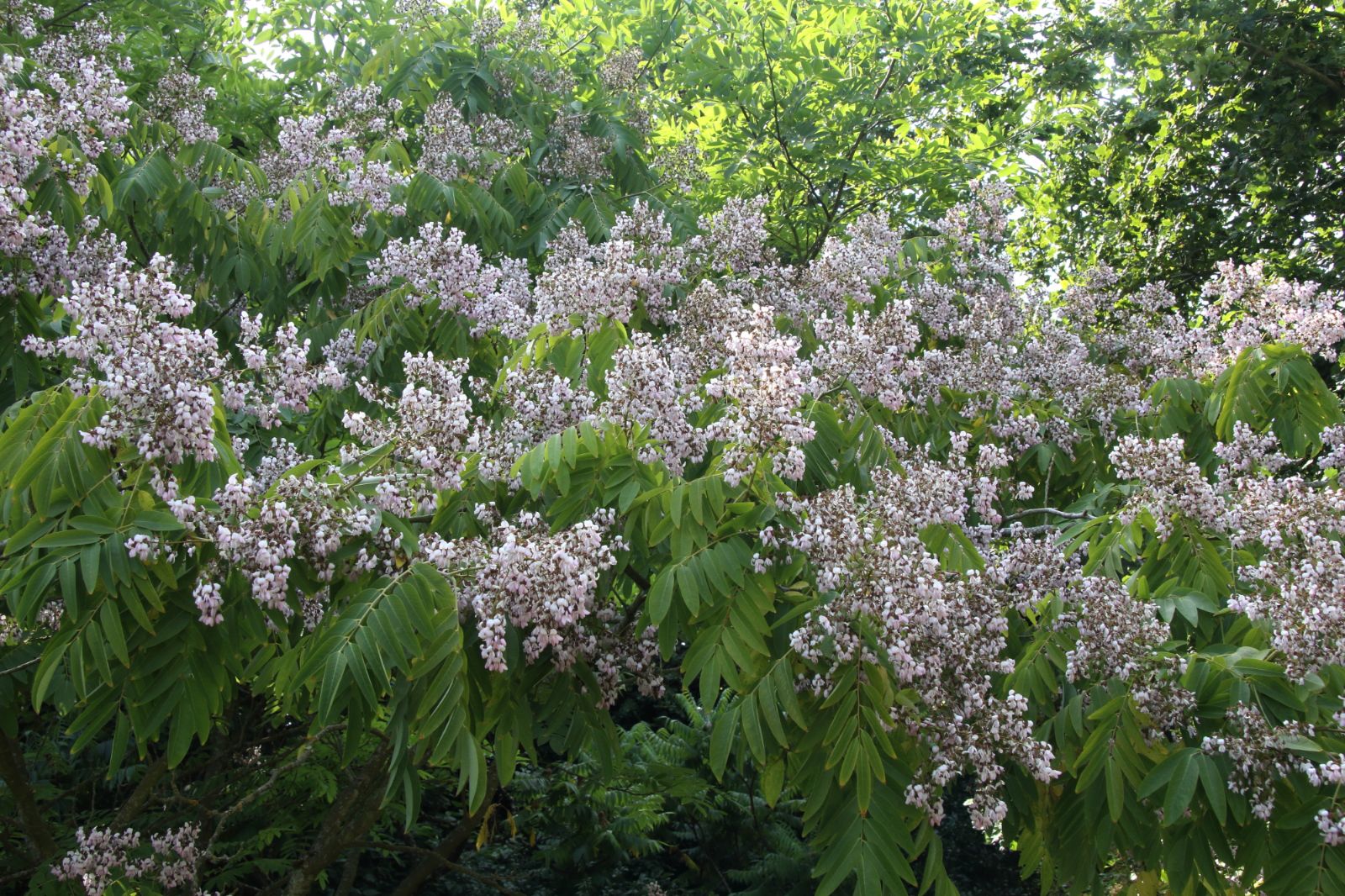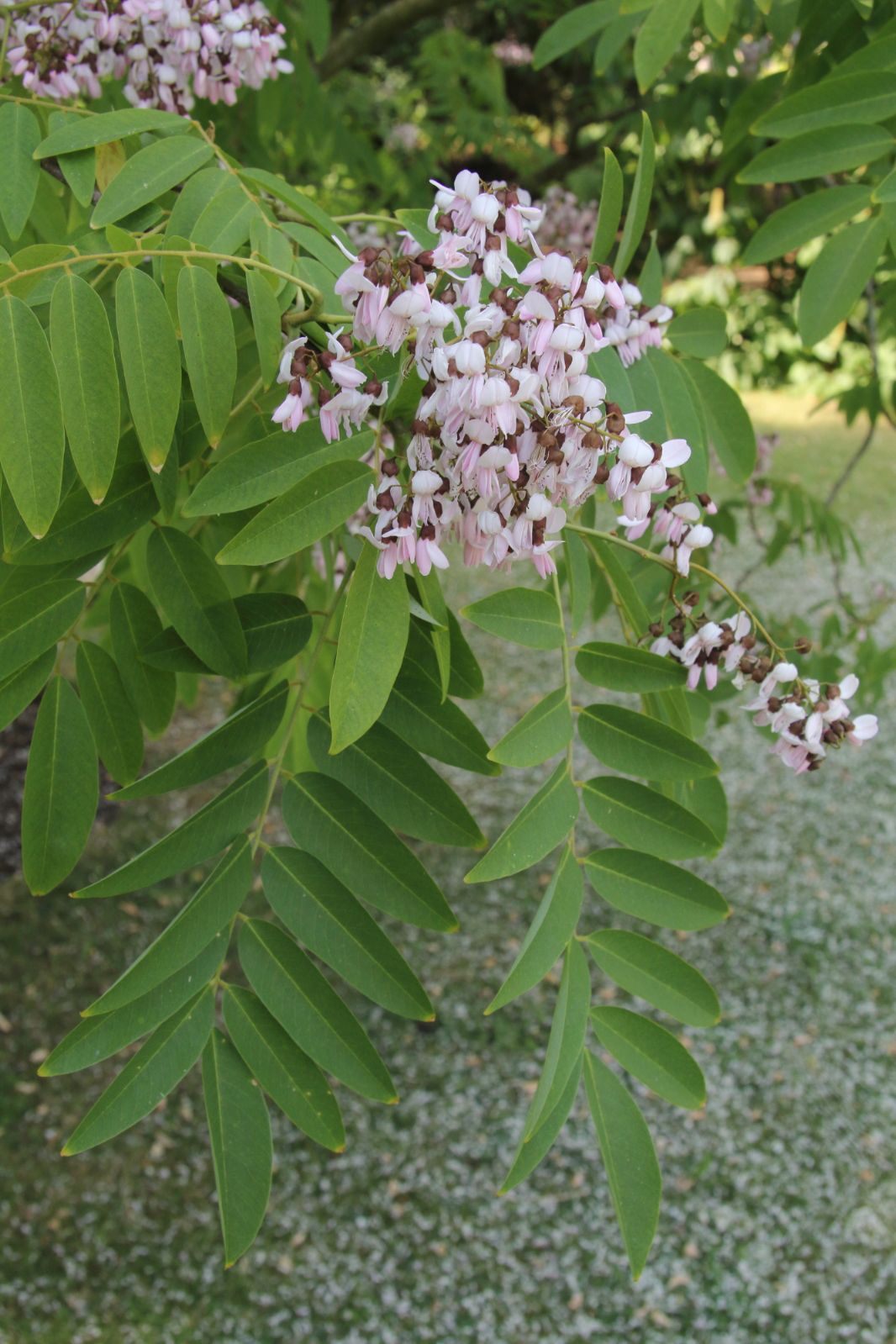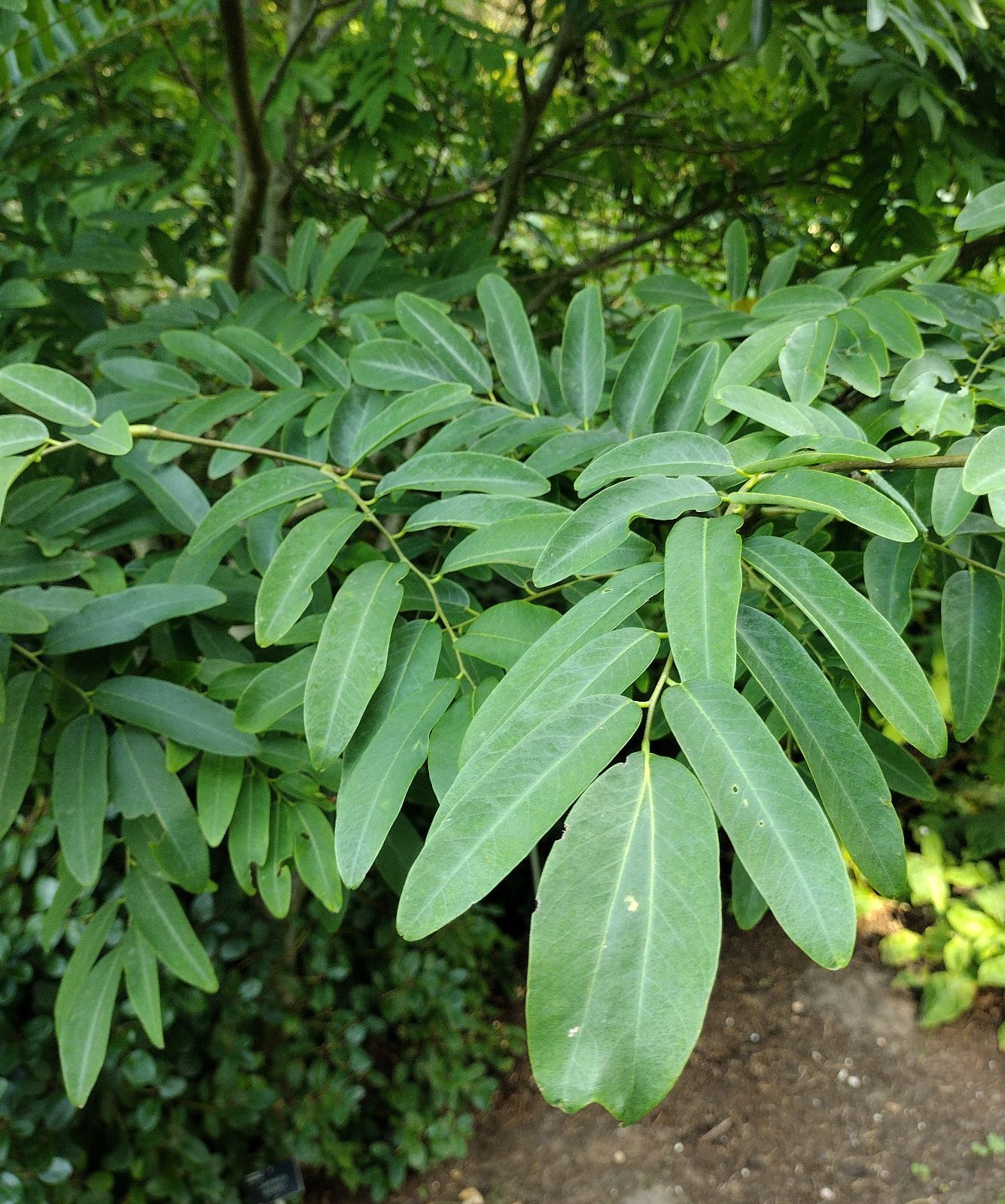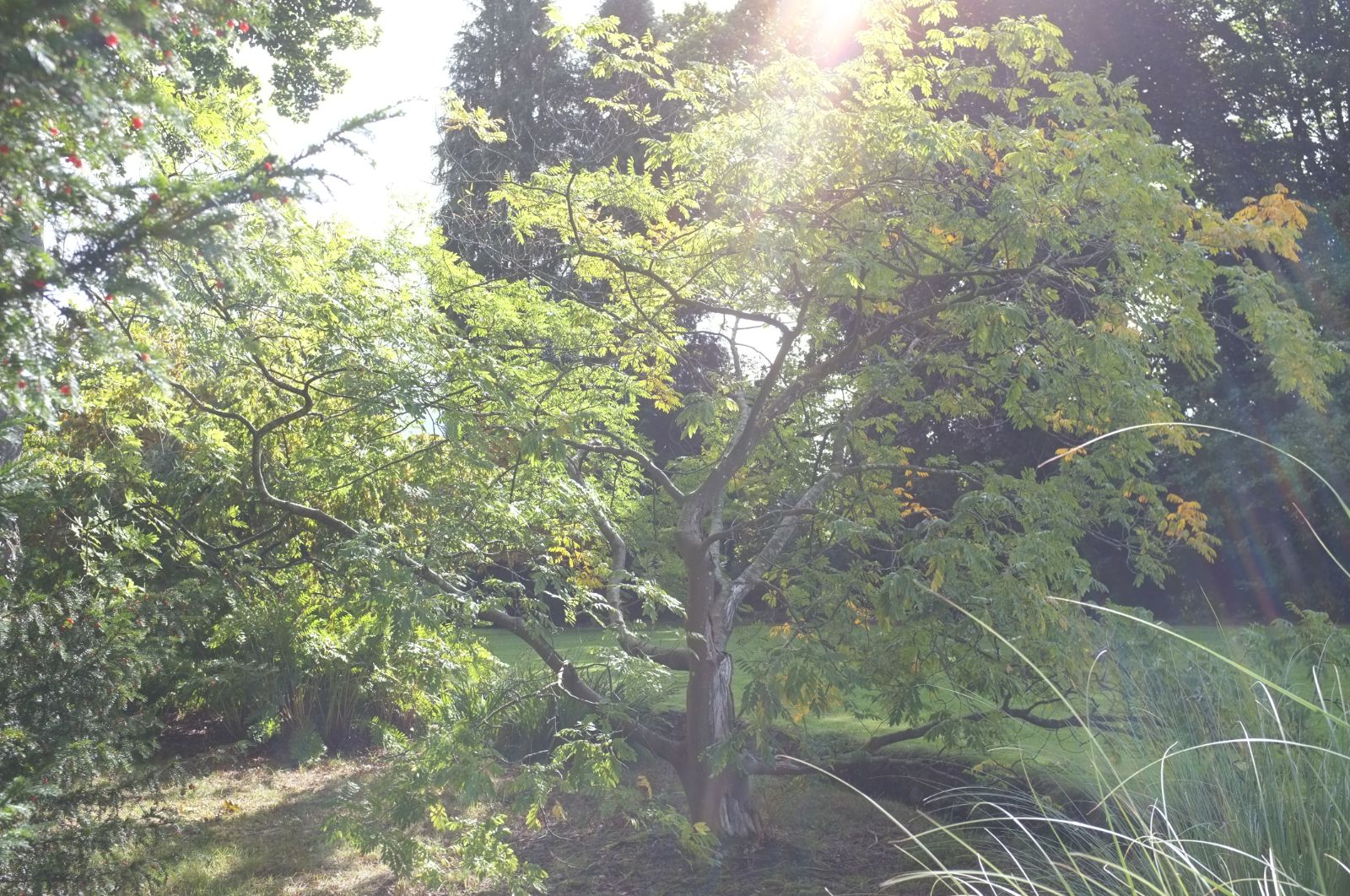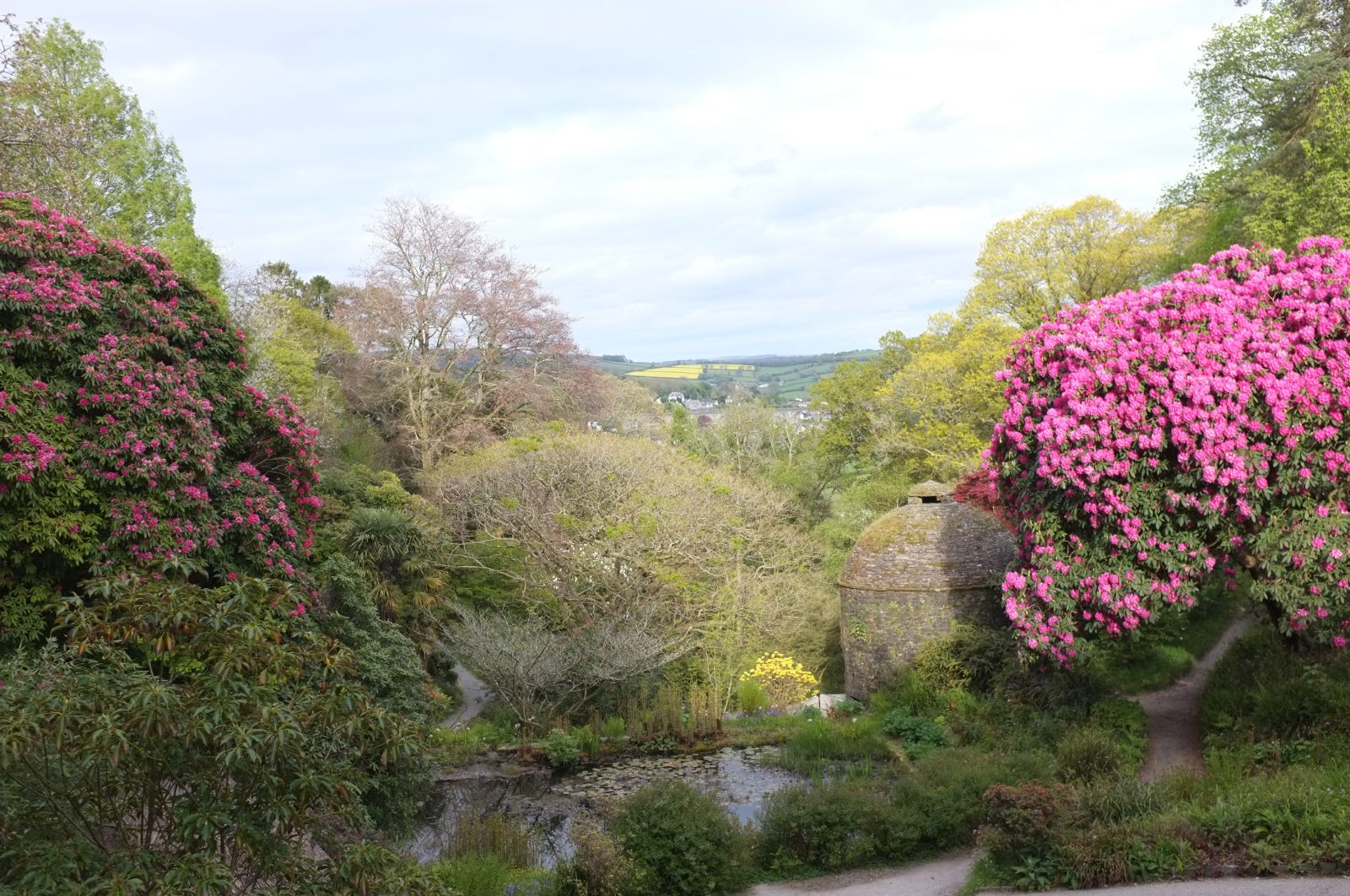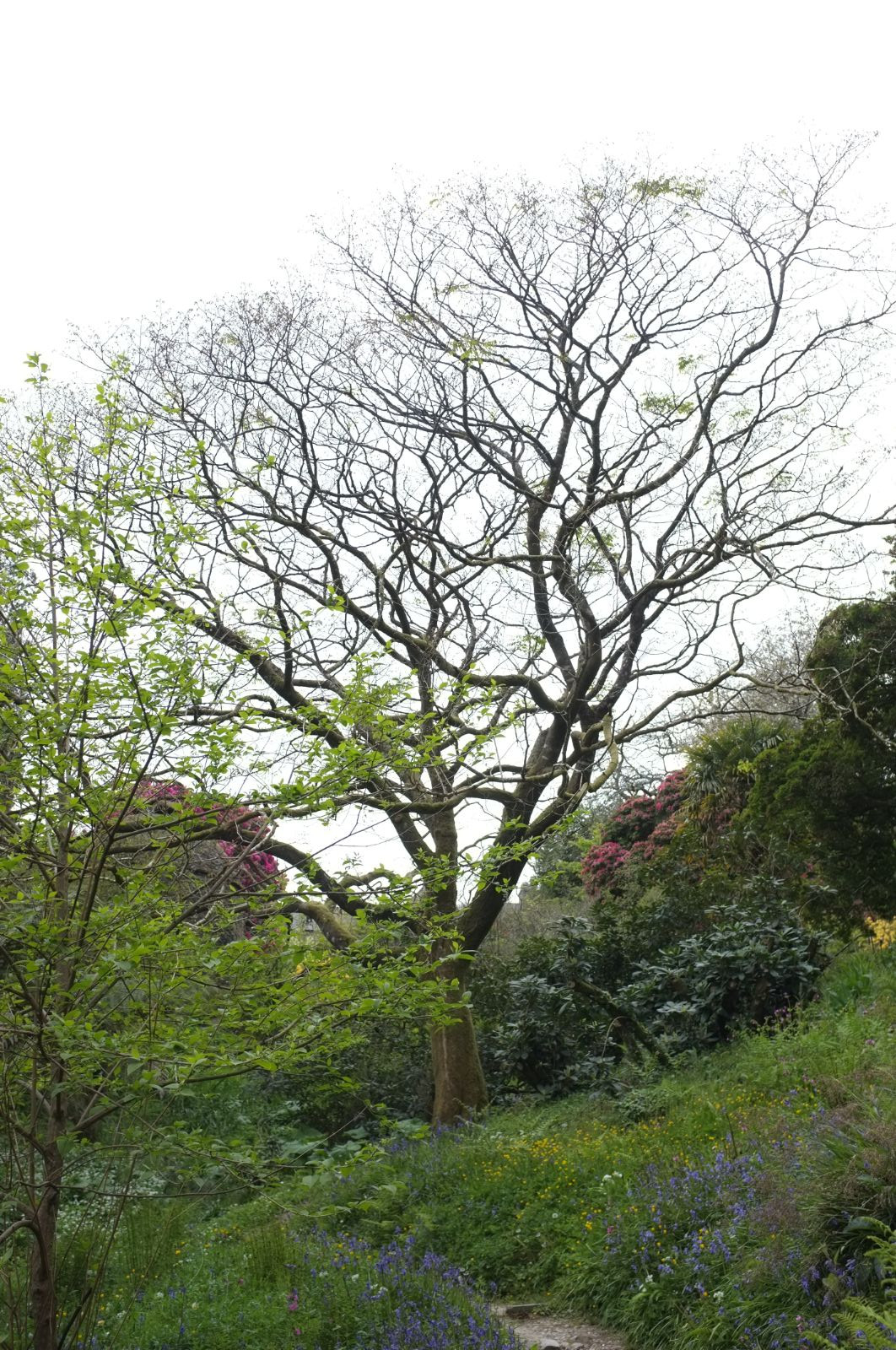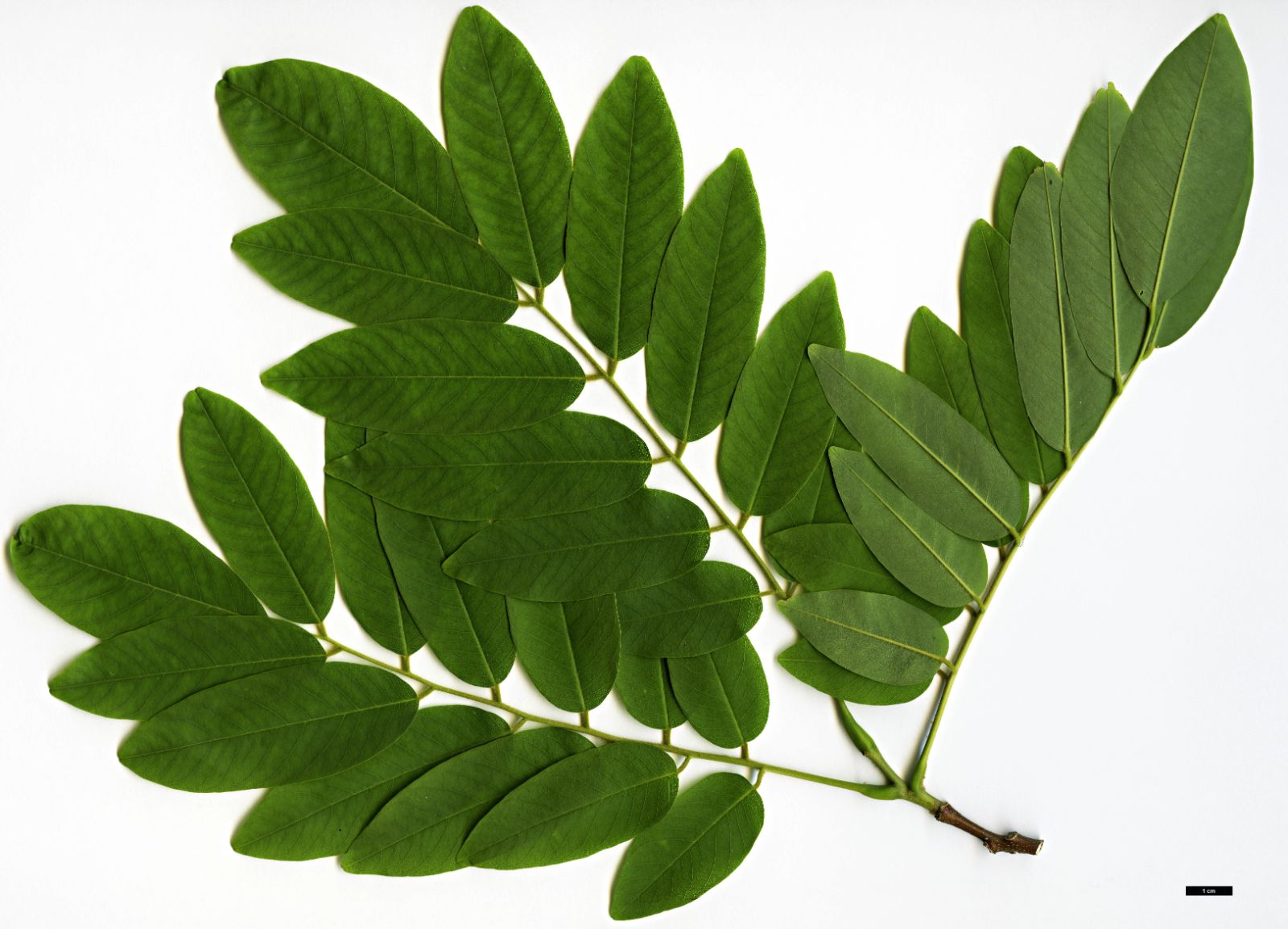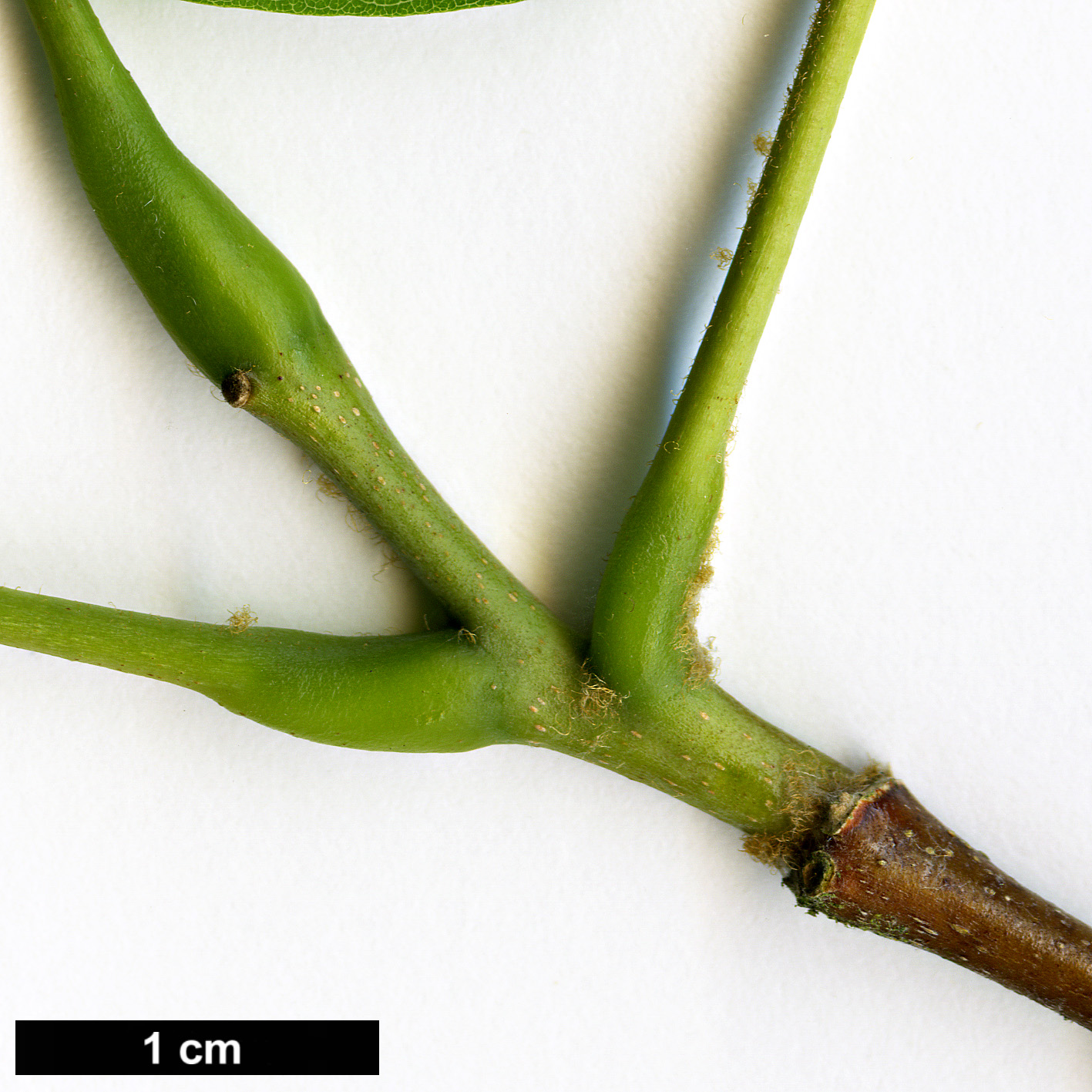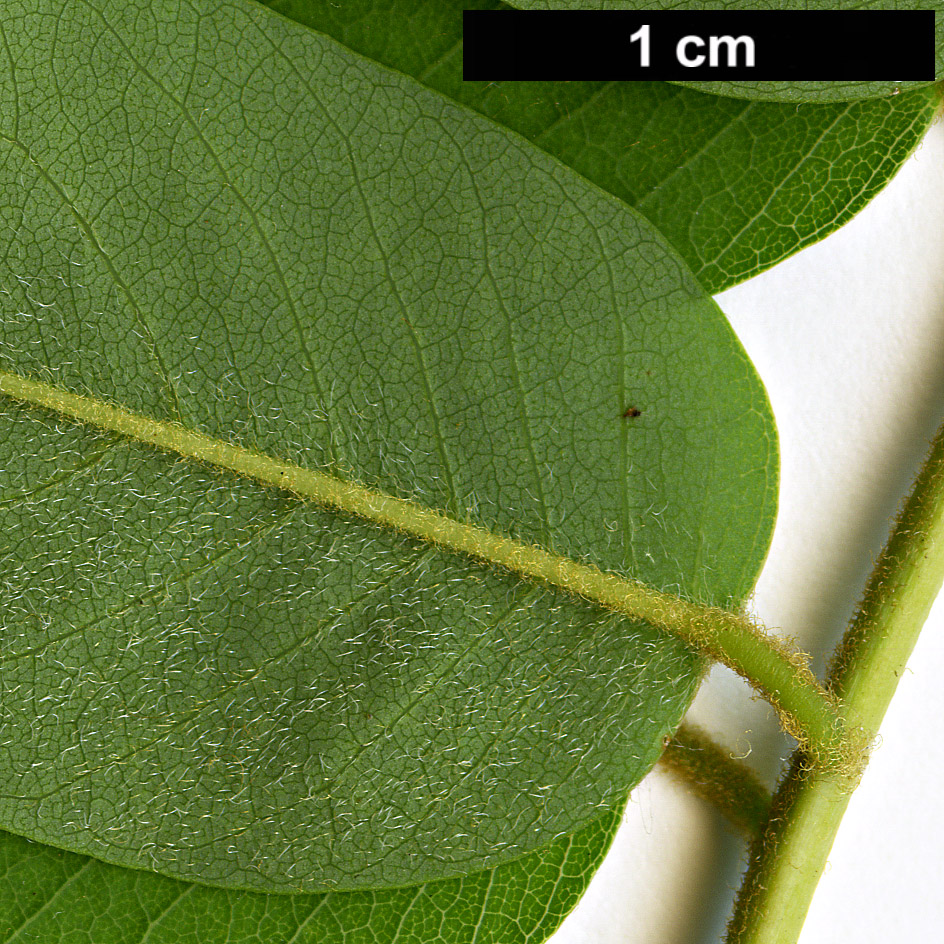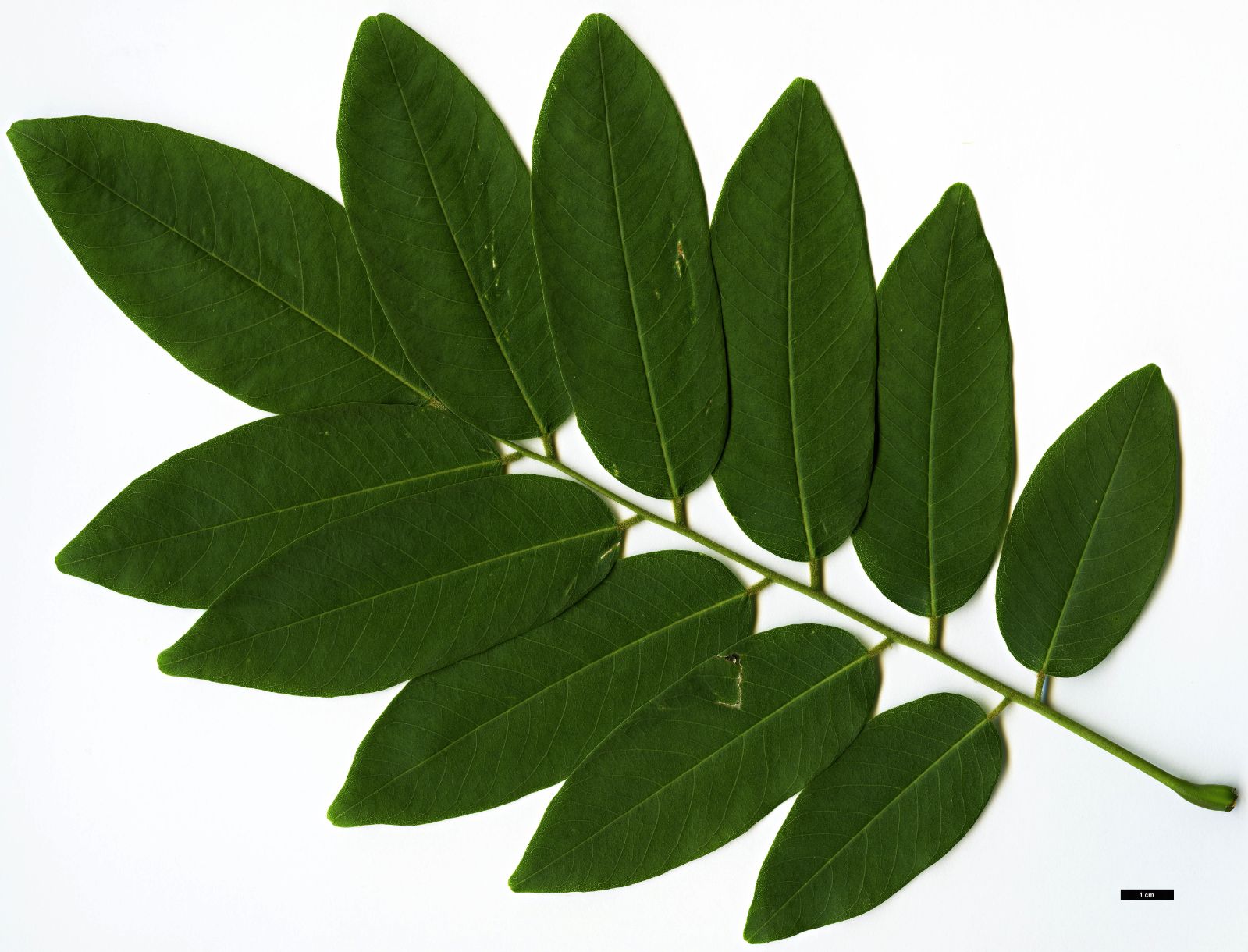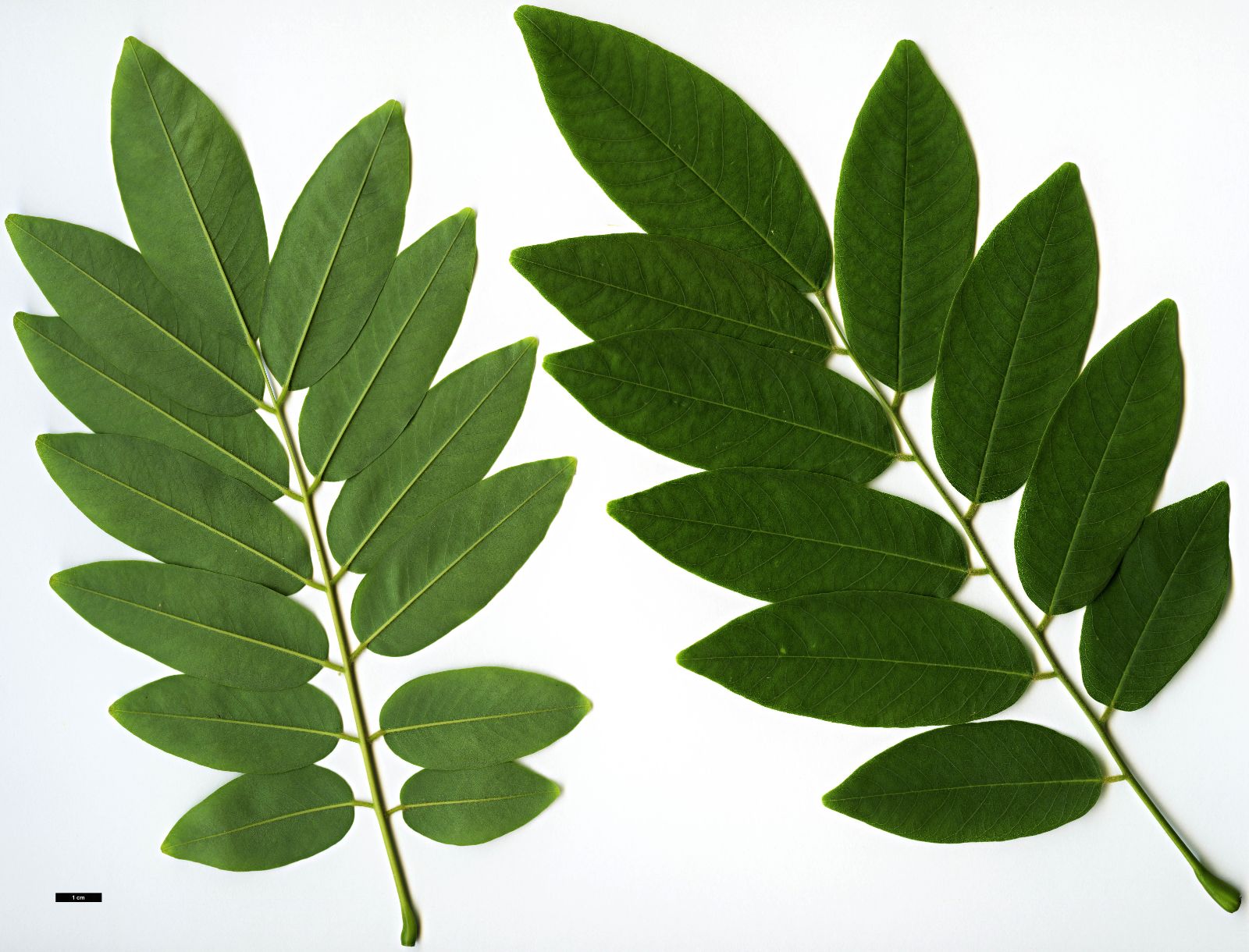Cladrastis delavayi
Credits
Owen Johnson (2021)
Recommended citation
Johnson, O. (2021), 'Cladrastis delavayi' from the website Trees and Shrubs Online (treesandshrubsonline.
Genus
Common Names
- Chinese Yellow-wood
Synonyms
- Cladrastis sinensis Hemsley
- Dalbergia delavayi Franchet
Infraspecifics
Other taxa in genus
Tree to 20 m tall, typically with a spreading or domed habit from a short bole. Bark grey, thin, remaining smooth with patterns of round lenticels. Shoots grey-brown, with a rusty or whitish pubescence when young; buds short, hidden in the swollen base of the rachis through summer. Leaves to 20 cm long, with 9–13 closely-set leaflets which are borne alternately on pubescent petiolules 1–3 mm long; each leaflet is narrowly ovate-lanceolate or oblong-lanceolate, 4–11.5 × 1.7–3.8 cm, broadest towards the base which is obtuse to slightly cordate, and acute or characteristically rounded at the tip; underside greyish and pubescent. Inflorescence a terminal, erect panicle or raceme, 12–30 cm long, flowers opening June-August (in China). Calyx campanulate, 5 × 7 mm, with 5 semiorbicular teeth and a dense rusty or whitish pubescence. Corolla white or yellowish or less often pale pink; flowers c. 15 mm. Ovary light-yellow pilose. Fruit-pods ripening August-October (in China) , flattened, smooth, 3–8 × 1–2 cm, with 1–3(–5) seeds which are brown, ovoid and compressed, c. 4 × 2 mm. (Flora of China 2021; Bean 1976).
Distribution Bhutan In the Himalaya China Fujian, Gansu, Guangxi, Guizhou, Hubei, Hunan, Shaanxi, Sichuan, Yunnan.
Habitat Hill forests with hot humid summers and short winters, at 1000–2500 m asl.
USDA Hardiness Zone 5
RHS Hardiness Rating H6
Conservation status Least concern (LC)
Taxonomic note This species was long known by Hemsley’s name Cladrastis sinensis, for which Franchet’s Dalbergia delavayi is generally considered a synonym. Franchet’s description was published two years before Hemsley’s, so Prain’s 1904 combination C. delavayi is the correct name for this tree. This name was adopted by Govaerts (1995) more than twenty years ago, but has still to gain widespread use.
The commonest and most widespread of the east Asian species of Cladrastis, C. delavayi was first described from Sichuan by A.E. Pratt in 1890 and first collected by E.H. Wilson in Hubei in 1901 (Bean 1976). Subsequent Wilson collections (grouped under the field number W 1102) allowed it to be grown quite widely in gardens in England and Ireland, and more rarely in continental Europe and the western United States. (The extension of the native range south-westwards into the eastern Himalaya is indicated by one record from Bhutan (Bhutan Biodiversity Specimen Portal 2021); records appear absent from the intervening Indian Himalaya.)
The most obvious feature distinguishing C. delavayi from the more familiar American C. kentukea lies in the former tree’s smaller and much narrower but more numerous leaflets, which may even suggest the foliage of Pterocarya stenoptera in their oblong shape and close placement. The yellow-wood, however, is much more elegant and refined-looking as a foliage tree than is the wingnut, and it shares with the rest of its genus (and with Platyosprion) the remarkable, alternate arrangement of the leaflets along the central stalk. The flowers open in high summer rather than soon after the spring flush as they do in the case of C. kentukea, and the flowerhead is erect rather than drooping; the blossom is similarly sweet-scented but can be produced every year, and is likelier to be creamy or flushed with pink, rather than pure white. As is the case for the American species, plants tend not to flower until they are seven to ten years old. Autumn colour is a good yellow, or orange-red if summers are warm enough, but tends in Britain to start later than C. kentukea and may be disappointing.
In Britain, however, C. delavayi flowers much more reliably than C. kentukea and is more likely to luxuriate, making it the superior choice as an ornamental. This said, it is still far from being a familiar flowering tree, and the regrettable but necessary change of name from C. sinensis is unlikely to help its cause. It is one of very few summer-flowering trees to be at its best in the Atlantic fringe of Cornwall, Ireland and western Scotland, whose great gardens are inevitably dominated by spring-flowering evergreens. The largest example, in the valley at Cotehele in Cornwall, was 14 m tall in 2017 with a great domed crown supported by a clean bole 71 cm dbh; the tallest, 17 m in 2006, was at Bosahan, by the gate to the coastal path. Other outstanding specimens grow at the Castlewellan National Arboretum and at Rowallane (both in Co. Down), at Lanarth and at Trewithen in Cornwall (the former much retrenched when last seen in 2006), and in woodland shelter at Achamore on Gigha (Tree Register 2021). Outside these areas, mature trees of good stature are scarce; a superb specimen was chanced upon by the author in 2018 in a front garden at Sheepscombe Far End in the Gloucestershire Cotswolds. Flowering seems more reliable when summers are warm, as in the Cambridge University Botanic Garden where there is a young tree (Cambridge University Botanic Garden 2021), but the Tree Register includes no specimens at all from the colder parts of Britain, north and east of The Hollies in suburban Leeds – a public park on the site of the gardens of the Brown family where a remarkable variety of rare trees continues to be cultivated. (For a discussion of the fine tree grown as C. delavayi at East Bergholt Place in Suffolk, see Platyosprion platycarpum.)
It would be easy to assume from this dataset that C. delavayi is too tender to survive across Britain as a whole. In the wild, however, it endures short but significantly cold winters and it is more accurate to state that – like Albizia julibrissin or Firmiana simplex, which are more extreme cases – it needs prolonged summer warmth to be able to ripen its wood well enough to survive a hard winter. The UK data does, however, suggest that – like Cunninghamia for example – it greatly prefers the cool but well-watered summers of the west, which are typically followed by very mild winters, to the slightly warmer but drier summers of the east, which can quickly give way to relatively hard frosts. One marked characteristic – helping to indicate that C. delavayi finds no perfect match to its preferred growing conditions anywhere in Britain – is that it is generally the last tree of all into leaf. Several examples have been recorded by the author for The Tree Register in May or early June with the comment ‘dead?’, only to be found in perfect health on return visits later in subsequent years.
Like its American cousin, C. delavayi is happy in an alkaline soil and has been successfully cultivated in a few inches of humus over raw chalk at Highdown on the West Sussex Downs. This tree will however have found Highdown’s free-draining soil and dehydrating sea winds a challenge, and my comment ‘dead?’ in 2007 does seem in this case to have been an accurate prediction.
Cladrastis delavayi has been grown successfully in a few gardens in continental Europe with colder winters, but rather longer and hotter summers. There is a specimen in the Utrecht Botanic Garden (Utrecht Botanic Garden), and another in Graz Botanic Garden in Austria (Graz Botanic Garden). In France, the species is sold by Pépinière des Avettes (Pépinière des Avettes 2021) and Pépinière Aoba (Pépinière Aoba 2021).
In the United States, estimates of the climate zone to which the species is hardy range from zones 4 to 6, but there seem to be too few specimens for any of this to be more than guesswork – with the claims for the greatest hardiness presumably based on an assumption that the species’ tolerance will be the same as that of the native C. kentukea. The clone ‘China Rose’ (q.v.) has however been selected in the eastern States. Randy Stewart (Stewart 2021) observes, more precisely, that the species thrives in the Pacific North-west; it is cultivated at Bellevue Botanic Garden in Washington State (Bellevue Botanic Garden 2021). In Australia, a tree was 14 m tall in 1993 in a front garden in South Yarra, Victoria, but has since been removed (National Trusts of Australia 2020).
'China Rose'
Synonyms / alternative names
Cladrastis delavayi 'Rosea'
This pink-flowered selection (Duley & Vincent 2003) was originally distributed in the United States under the illegitimate name ‘Rosea’. A specimen was planted in 2001 at the J.C. Raulston Arboretum in North Carolina (JC Raulston Arboretum 2020), and the cultivar is also grown at the Bellevue Botanic Garden in Washington State (Bellevue Botanic Garden 2021). Cladrastis delavayi when grown from seed is much more likely than C. kentukea to show a pink cast to its flowers.
‘China Rose’ does not seem to have been introduced to Europe.

